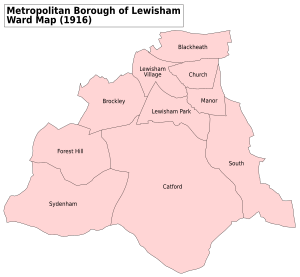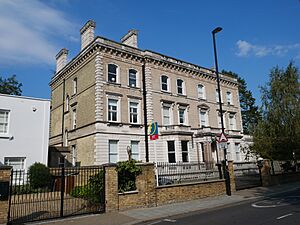Lee, London facts for kids
Quick facts for kids Lee |
|
|---|---|
 St Margaret's Church, Lee, rebuilt between 1839 and 1841 |
|
| Population | 14,573 (Lee Green ward, 2011 Census) |
| OS grid reference | TQ395745 |
| London borough | |
| Ceremonial county | Greater London |
| Region | |
| Country | England |
| Sovereign state | United Kingdom |
| Post town | LONDON |
| Postcode district | SE12 |
| Dialling code | 020 |
| Police | Metropolitan |
| Fire | London |
| Ambulance | London |
| EU Parliament | London |
| UK Parliament |
|
| London Assembly |
|
Lee, also known as Lee Green, is an area in South East London, England. It sits right on the edge of two London boroughs: Lewisham and the Royal Borough of Greenwich. You can find it northwest of Eltham and southeast of Lewisham. Long ago, it was part of Kent. It then became part of the County of London in 1889, and finally Greater London in 1965.
The churchyard of St Margaret's Church is a special place. The current church was rebuilt between 1839 and 1841. Three famous Astronomers Royal are buried there: Edmond Halley, Nathaniel Bliss, and John Pond.
Contents
History
Early history
The Manor of Lee was a historic parish, like a small district. It existed until 1900. Then, it joined with the parish of Lewisham to create the Metropolitan Borough of Lewisham. Today, modern Lee is mostly around Lee railway station and the road called Burnt Ash Hill. However, the old parish was centered on Lee High Road. This road now stretches into the town center of Lewisham. The River Quaggy formed much of the boundary between the two parishes. At Lee Bridge, it is now almost completely hidden.
The Domesday Book from 1086 described Lee as a small farming area. It was set within a large woodland. The earliest map we have, from 1746, shows a small village. It had about a dozen houses clustered around a triangular village green. This hamlet was mostly surrounded by fields. To the north was the Wricklemarsh estate, owned by Sir Gregory Page. A manor house, Lee Place, was to the north-west, with St Margaret's Church nearby. Lee Green Farm was located in the south-east part from the 1660s. This is roughly where the present Leegate shopping center is. The farm was taken down in the 1840s. It was rebuilt as Tudor House further east.
The Old Tiger's Head and the New Tiger's Head pubs are important landmarks. It's a bit confusing, but the original Old Tiger's Head was likely built where the New Tiger's Head is now. The first pub was probably built before 1730. It was rebuilt on its current site, in the north-west, between 1750 and 1770. Then it was rebuilt again in 1896. This date is on its front. It became an important stop for mail and coaching inns. The New Tiger's Head started as a beer shop in the 1830s. It was called the Tiger Tavern. It was part of four cottages called Prospect Terrace. Three of these cottages still exist today. The New Tiger's Head has now closed down.
19th century
In 1815, cavalry and foot soldiers marched through Lee Green. They were on their way to the Battle of Waterloo. The space in front of the Tiger's Head and the Green was very useful. It allowed them to transfer baggage to different wagons.
Lee is also where, in 1837, Robert Cocking died. This was the first ever parachute accident.
In the early 1800s, boxing matches took place at the Old Tiger's Head. Horse racing and foot racing also happened in the 1840s. However, the police stopped these events. This was probably because local people complained. At that time, the green was the center of village life. There were cricket matches, bare-knuckle boxing, and other fun events. In the 1850s, more houses were built. This led to proper sewers being installed. The Lee Green horse pond was also filled in. In the 1860s, a developer named John Pound built houses. These included Orchard Terrace and Crown Terrace.
The opening of Lee station in 1866 led to even more house building. The site of Lee Green Farm was built on. It became Carston Mews. In the same year, Charles Henry Reed, a linen draper, opened a department store. Reed died in 1895. In 1903, Griffith & Co took over the business.
In the south-west area, the Prince Arthur pub was built in 1870. It closed in 2005. It was originally one of a row of early 19th-century cottages. Three of these cottages still survive. In 1898, a building was constructed in front of the old Tiger's Head stables. It included a fire station. However, the London County Council built a new one in 1906. This new fire station is still in use today. A police station was built in 1904. It replaced an older one from before 1860. This police station was turned into apartments in 2003.
20th century to now
In the early 1960s, the south-east area was cleared. This included Carston Mews. It made way for the Leegate shopping center. This center became less popular after a Sainsbury's supermarket opened nearby. The owners of the center, St. Modwen Properties, have suggested a big plan. They want to spend £40 million to rebuild the center. This would include tearing down the current shops. An Asda supermarket would be built, and the office block would become a hotel.
Notable residents

Many interesting people have lived in Lee:
- Sir Francis Baring started Baring Brothers Bank. He bought the Manor House in 1796. This house is now a library, and its grounds are a public park called Manor House Gardens.
- Henry Thomas Buckle, a historian, was born in Lee.
- Poet Ernest Dowson was born in Lee.
- Poet U A Fanthorpe was born in Lee.
- Actor James Robertson Justice was born in Lee in 1907.
- Actor Jude Law has lived in Lee.
- Musician Manfred Mann lived in Southbrook Road.
- Philosopher and historian Karl Marx lived in Lee for a short time.
- John Mayall lived in Lee Green. Musician Eric Clapton stayed with him.
- Sir Gregory Page built a large mansion. It was called Wricklemarsh.
- Mechanical engineer John Penn died at his home in Lee in 1878. He was buried at St Margaret's Church.
- Reggie Schwarz, a South African cricketer, was born in Lee.
- Comedian Arthur Smith lived in Lee briefly. He went to Roan Boys' Grammar School.
- Stanley Unwin, a publisher, lived in Handen Road.
- Max Wall, an actor and comedian, lived here.
- Estelle Winwood, an English actress, lived in Lee. She later moved to the US.
Gallery
Transport
Road
Lee High Road is the main road through the area. It is part of the A20 road.
Rail
Lee station serves the area. It has National Rail services to London Charing Cross and London Cannon Street. You can also get to Woolwich Arsenal and Gravesend.
Buses
Lee is served by many London Buses routes. These include 122, 160, 178, 202, 261, 273, 321, 621, 660, and N21. These buses connect Lee to areas like Blackheath, Bromley, Catford, Chislehurst, Crystal Palace, Eltham, Grove Park, Kidbrooke, Lewisham, New Cross, Petts Wood, Plumstead, Sidcup, Sydenham, and Woolwich.
Nearby areas
 |
Lewisham | Blackheath | Kidbrooke |  |
| Hither Green, Ladywell |
Eltham, Well Hall |
|||
| Catford | Grove Park | Horn Park, Mottingham |









